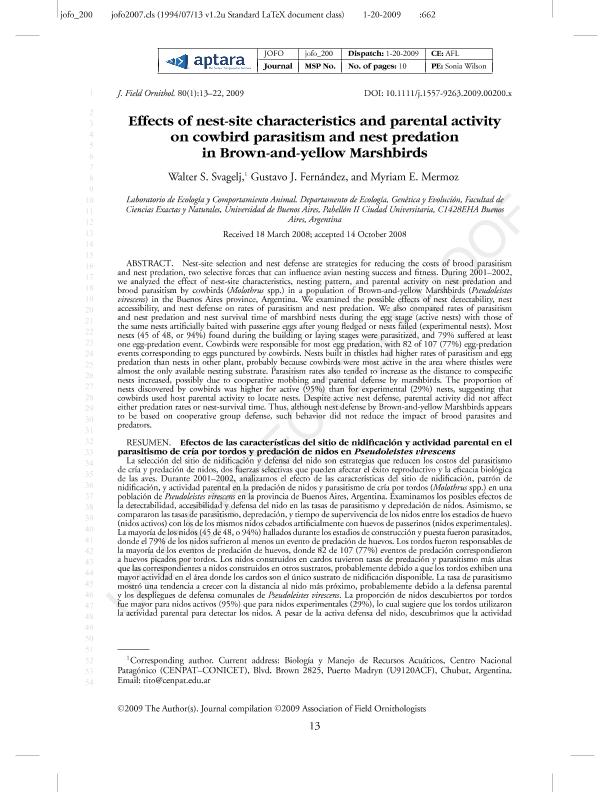Artículo
Effects of nest-site characteristics and parental activity on cowbird parasitism and nest predation in Brown-and-yellow Marshbirds
Título:
Efectos de las características del sitio de nidificación y actividad parental en el
parasitismo de cría por tordos y predación de nidos en Pseudoleistes virescens
Fecha de publicación:
03/2009
Editorial:
Wiley Blackwell Publishing, Inc
Revista:
Journal Of Field Ornithology
ISSN:
0273-8570
Idioma:
Inglés
Tipo de recurso:
Artículo publicado
Clasificación temática:
Resumen
Nest-site selection and nest defense are strategies for reducing the costs of brood parasitism and nest predation, two selective forces that can influence avian nesting success and fitness. During 2001-2002, we analyzed the effect of nest-site characteristics, nesting pattern, and parental activity on nest predation and brood parasitism by cowbirds (Molothrus spp.) in a population of Brown-and-yellow Marshbirds (Pseudoleistes virescens) in the Buenos Aires province, Argentina. We examined the possible effects of nest detectability, nest accessibility, and nest defense on rates of parasitism and nest predation. We also compared rates of parasitism and nest predation and nest survival time of marshbird nests during the egg stage (active nests) with those of the same nests artificially baited with passerine eggs after young fledged or nests failed (experimental nests). Most nests (45 of 48, or 94%) found during the building or laying stages were parasitized, and 79% suffered at least one egg-predation event. Cowbirds were responsible for most egg predation, with 82 of 107 (77%) egg-predation events corresponding to eggs punctured by cowbirds. Nests built in thistles had higher rates of parasitism and egg predation than nests in other plant, probably because cowbirds were most active in the area where thistles were almost the only available nesting substrate. Parasitism rates also tended to increase as the distance to conspecific nests increased, possibly due to cooperative mobbing and parental defense by marshbirds. The proportion of nests discovered by cowbirds was higher for active (95%) than for experimental (29%) nests, suggesting that cowbirds used host parental activity to locate nests. Despite active nest defense, parental activity did not affect either predation rates or nest-survival time. Thus, although nest defense by Brown-and-yellow Marshbirds appears to be based on cooperative group defense, such behavior did not reduce the impact of brood parasites and predators.
Archivos asociados
Licencia
Identificadores
Colecciones
Articulos(CCT-CENPAT)
Articulos de CTRO.CIENTIFICO TECNOL.CONICET - CENPAT
Articulos de CTRO.CIENTIFICO TECNOL.CONICET - CENPAT
Articulos(IEGEBA)
Articulos de INSTITUTO DE ECOLOGIA, GENETICA Y EVOLUCION DE BS. AS
Articulos de INSTITUTO DE ECOLOGIA, GENETICA Y EVOLUCION DE BS. AS
Citación
Svagelj, Walter Sergio; Fernandez, Gustavo Javier; Mermoz, Myriam Emilia; Effects of nest-site characteristics and parental activity on cowbird parasitism and nest predation in Brown-and-yellow Marshbirds; Wiley Blackwell Publishing, Inc; Journal Of Field Ornithology; 80; 1; 3-2009; 9-18
Compartir
Altmétricas




